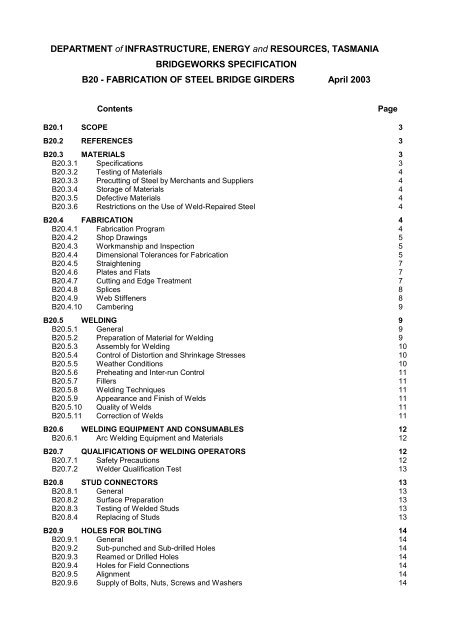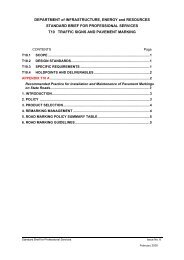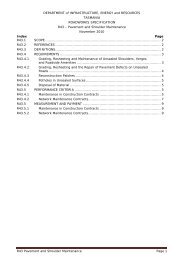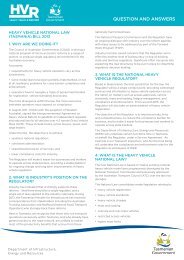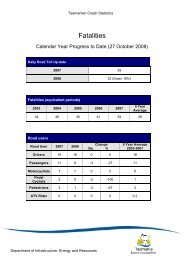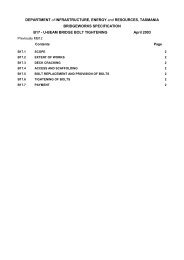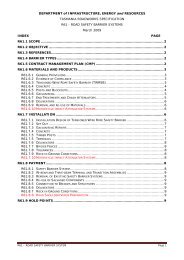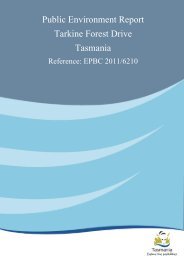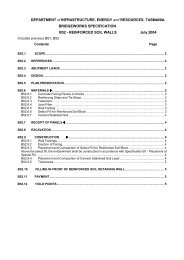Fabrication of Steel Bridge Girders - Transport
Fabrication of Steel Bridge Girders - Transport
Fabrication of Steel Bridge Girders - Transport
Create successful ePaper yourself
Turn your PDF publications into a flip-book with our unique Google optimized e-Paper software.
DEPARTMENT <strong>of</strong> INFRASTRUCTURE, ENERGY and RESOURCES, TASMANIABRIDGEWORKS SPECIFICATIONB20 - FABRICATION OF STEEL BRIDGE GIRDERS April 2003ContentsPageB20.1 SCOPE 3B20.2 REFERENCES 3B20.3 MATERIALS 3B20.3.1 Specifications 3B20.3.2 Testing <strong>of</strong> Materials 4B20.3.3 Precutting <strong>of</strong> <strong>Steel</strong> by Merchants and Suppliers 4B20.3.4 Storage <strong>of</strong> Materials 4B20.3.5 Defective Materials 4B20.3.6 Restrictions on the Use <strong>of</strong> Weld-Repaired <strong>Steel</strong> 4B20.4 FABRICATION 4B20.4.1 <strong>Fabrication</strong> Program 4B20.4.2 Shop Drawings 5B20.4.3 Workmanship and Inspection 5B20.4.4 Dimensional Tolerances for <strong>Fabrication</strong> 5B20.4.5 Straightening 7B20.4.6 Plates and Flats 7B20.4.7 Cutting and Edge Treatment 7B20.4.8 Splices 8B20.4.9 Web Stiffeners 8B20.4.10 Cambering 9B20.5 WELDING 9B20.5.1 General 9B20.5.2 Preparation <strong>of</strong> Material for Welding 9B20.5.3 Assembly for Welding 10B20.5.4 Control <strong>of</strong> Distortion and Shrinkage Stresses 10B20.5.5 Weather Conditions 10B20.5.6 Preheating and Inter-run Control 11B20.5.7 Fillers 11B20.5.8 Welding Techniques 11B20.5.9 Appearance and Finish <strong>of</strong> Welds 11B20.5.10 Quality <strong>of</strong> Welds 11B20.5.11 Correction <strong>of</strong> Welds 11B20.6 WELDING EQUIPMENT AND CONSUMABLES 12B20.6.1 Arc Welding Equipment and Materials 12B20.7 QUALIFICATIONS OF WELDING OPERATORS 12B20.7.1 Safety Precautions 12B20.7.2 Welder Qualification Test 13B20.8 STUD CONNECTORS 13B20.8.1 General 13B20.8.2 Surface Preparation 13B20.8.3 Testing <strong>of</strong> Welded Studs 13B20.8.4 Replacing <strong>of</strong> Studs 13B20.9 HOLES FOR BOLTING 14B20.9.1 General 14B20.9.2 Sub-punched and Sub-drilled Holes 14B20.9.3 Reamed or Drilled Holes 14B20.9.4 Holes for Field Connections 14B20.9.5 Alignment 14B20.9.6 Supply <strong>of</strong> Bolts, Nuts, Screws and Washers 14
B20.10 INSPECTION AND CORRECTION OF DEFECTS 15B20.10.1 General 15B20.10.2 Measurement <strong>of</strong> Girder Dimensions and Camber 15B20.10.3 Inspection <strong>of</strong> Welds 15B20.10.4 Radiographic or Ultrasonic Inspection 15B20.10.5 Cost <strong>of</strong> Testing 16B20.10.6 Correction <strong>of</strong> Distortion 16B20.11 END PREPARATION OF GIRDER SEGMENTS 16B20.12 SHOP ASSEMBLY 16B20.13 DEFECTIVE WORKMANSHIP 16B20.14 TRANSPORT AND DELIVERY 17B20.15 PAYMENT 17B20.16 HOLDPOINTS 17B20.17 INFORMATION TO BE INCLUDED IN CONTRACT MANAGEMENT PLAN 18
B20 - FABRICATION OF STEEL BRIDGE GIRDERS April 2003B20.1 SCOPEThis Specification sets out the requirements for the supply, fabrication, shop assembly and transportto the site <strong>of</strong> bridge steelwork including beams, diaphragms, cross frames and associated fittings.B20.2 REFERENCESThe following Australian Standards are referred to in this Specification.A.S. 1100 Technical DrawingA.S. 1101 Graphic symbols for general engineeringA.S. 1111 ISO metric hexagon boltsAS 1112 ISO metric hexagon nutsA.S. 1163 Structural steel hollow sections.A.S. 1252 High strength steel bolts for structural engineeringA.S. 1553 Covered electrodes for weldingA.S. 1554 Structural steel weldingA.S. 1710 Non destructive testingA.S. 1789 Electro plated coatings - ZincA.S. 1790 Electro plated coatings - CadmiumA.S. 1796 Certification <strong>of</strong> welders and welding supervisorsA.S. 1858 Electrodes & fluxes for submerged arc weldingA.S. 2812 Welding, brazing & cutting <strong>of</strong> metals - Glossary <strong>of</strong> termsA.S. 3678 Hot rolled structural steel plates, floor plates and slabs,A.S. 3679 Hot rolled structural steel bars and sectionsA.S. 4100 <strong>Steel</strong> structuresA.S. 4680 Hot dip galvanised zinc coatingsB20.3 MATERIALSB20.3.1 SpecificationsStructural grade steel shall conform to the requirements <strong>of</strong> AS 3678, Hot Rolled Structural <strong>Steel</strong>Slabs, Plates and Floor Plates, and AS 3679, Hot Rolled Structural <strong>Steel</strong> Bars and Sections. Thegrade <strong>of</strong> steel shall be as shown on the Drawings.The dimensions <strong>of</strong> hot rolled structural steel sections shall conform to the requirements <strong>of</strong> AS 3679.Structural steel hollow sections shall conform to the requirements <strong>of</strong> AS 1163, Structural <strong>Steel</strong> HollowSections.All steel shall be new and shall be supplied in accordance with the provisions <strong>of</strong> AS 3678 and AS3679 with the following additions:(a) Test certificates are required for all steel.(b) All steel shall be ultrasonically tested to comply with level 2 <strong>of</strong> AS 1710. Longitudinalscanning is not required.(c) Product analysis is required.3 <strong>of</strong> 18 DIER SPEC B20
B20 - FABRICATION OF STEEL BRIDGE GIRDERS April 2003However any weld repairs carried out at the steel mills shall be clearly marked with paint and suchmarks shall be preserved by the merchant, supplier and/or fabricator until fabrication <strong>of</strong> the partcontaining the weld repaired steel is complete.Bolts and associated nuts and washers shall be <strong>of</strong> Commercial Grade 4.6 to AS 1111 or highstrength structural bolts to AS 1252 Grade 8.8. as shown on the Drawings. Hot dip galvanising asrequired shall be in accordance with AS 4680.Welding consumables shall be in accordance with AS 1554, Part 1. All girder butt welds shalldevelop the full strength <strong>of</strong> girder steel. Low hydrogen procedures shall be used at all flange splices.All electrode types proposed for use shall be detailed in the Contractor’s Contract ManagementPlan.B20.3.2 Testing <strong>of</strong> MaterialsThe Contractor shall retain evidence to show that all materials or parts conform to the tests inaccordance with AS 3678 and AS 3679. Such evidence shall be available for audit inspection.Test certificates shall show the results <strong>of</strong> mechanical tests and chemical analysis (where applicable)<strong>of</strong> the material or parts used in the work.All 'heat numbers', tags, stamps and other means <strong>of</strong> identifying steel with the test certificates shall bepreserved. Any steel that cannot be identified must be retested and passed before it may be used inthe work.The cost <strong>of</strong> all testing shall be borne by the Contractor.B20.3.3 Precutting <strong>of</strong> <strong>Steel</strong> by Merchants and SuppliersAny cutting or shaping <strong>of</strong> steel shapes and sections after the steel has left the steel mill shall beregarded as fabrication work and shall be carried out in accordance with this Specification. Any steelmerchant or supplier carrying out such precutting or shaping <strong>of</strong> steel for use in the bridge shall bedeemed to be a Sub-Contractor as defined in the General Conditions <strong>of</strong> Contract.B20.3.4 Storage <strong>of</strong> MaterialsAll steel, whether fabricated or not, shall be stored above the ground on platforms, skids or othersupports and adequately protected against corrosion. Excessively rusted, bent or damaged steel willbe rejected.B20.3.5 Defective MaterialsDefects arising from the manufacture <strong>of</strong> the steel that become evident at any stage <strong>of</strong> fabricationshall be the subject <strong>of</strong> a non-conformance report.The cost <strong>of</strong> repairs or replacement caused by such defects shall be borne by the Contractor.B20.3.6 Restrictions on the Use <strong>of</strong> Weld-Repaired <strong>Steel</strong>A piece <strong>of</strong> steel containing a surface defect which has been repaired by welding, where the weldrepair could create the effect <strong>of</strong> a notch that would be detrimental to a part <strong>of</strong> the structure subject tosignificant tensile stress or fatigue, shall be the subject <strong>of</strong> a non-conformance report.B20.4 FABRICATIONB20.4.1 <strong>Fabrication</strong> ProgramThe fabrication program shall form part <strong>of</strong> the Contractor’s Contract Management Plan. Thisprogram shall include the proposed system <strong>of</strong> identification and erection marks together withcomplete details <strong>of</strong> fabrication and welding procedures.Any departure from the program <strong>of</strong> approved fabrication and welding procedures as may be foundnecessary during the progress <strong>of</strong> the work shall be the subject <strong>of</strong> a revision to the ContractManagement Plan.The method <strong>of</strong> fabrication, procedure and sequence <strong>of</strong> welding shall be consistent with a minimum <strong>of</strong>distortion and <strong>of</strong> residual shrinkage stresses in the finished work.4 <strong>of</strong> 18 DIER SPEC B20
B20 - FABRICATION OF STEEL BRIDGE GIRDERS April 2003B20.4.2 Shop DrawingsThe Contractor shall be responsible for the preparation <strong>of</strong> shop drawings for all steelwork, includingtemporary falsework and erection equipment.All shop drawings shall be submitted in duplicate to the Superintendent for review not less than 21days prior to the anticipated date <strong>of</strong> commencement <strong>of</strong> fabrication. One copy <strong>of</strong> each drawing will bereturned to the Contractor with the Superintendent's comments and/or acceptance in writing within14 days after such submission. <strong>Fabrication</strong> shall not commence until receipt <strong>of</strong> the Superintendent'swritten acceptance.The drawings shall show full and complete information regarding the size, location and type <strong>of</strong> weldsand the sequence that shall be employed to minimise construction stresses and distortion. Theapproved welding procedures shall be fully detailed on the shop drawings and strictly adhered to inproduction.Review by the Superintendent shall indicate that the general requirements <strong>of</strong> the design have beensatisfied. Review shall not be taken to infer that the details, dimensions or the correct matching <strong>of</strong>connections or joints has been checked and this remains the responsibility <strong>of</strong> the Contractor.Drawings submitted for review shall be <strong>of</strong> good standard and any drawing that clearly requiresconsiderable amendment will be returned for alteration, without a review <strong>of</strong> the corrections that maybe required. Following alterations the drawings shall be resubmitted, and shall bear a revisionnumber or letter with all modifications being clearly indicated. Drawings shall be to AS 1100, weldingsymbols to AS 1101 and welding definitions to AS 2812.Variations from the shop drawings shall not be made except with the written agreement <strong>of</strong> theSuperintendent.B20.4.3 Workmanship and InspectionAll workmanship shall be <strong>of</strong> first class quality with accuracy sufficient to ensure that all parts will fittogether properly on erection.The welding shall be performed to Category SP <strong>of</strong> AS 1554, Part 1.The Superintendent shall have full liberty at all reasonable times to enter the Contractor's premisesfor the purpose <strong>of</strong> inspecting work. Any work found defective or which is not in accordance with theDrawings and Specification shall be the subject <strong>of</strong> a non-conformance report and shall be rectified orreplaced.The Contractor shall supply free <strong>of</strong> charge all labour, tools, scaffolding etc., required in connectionwith inspection <strong>of</strong> the work.B20.4.4 Dimensional Tolerances for <strong>Fabrication</strong>Measurements <strong>of</strong> length shall be checked with a certified steel measuring tape or band. Dimensions<strong>of</strong> the Drawings are for a temperature <strong>of</strong> 15 o C.Dimensions <strong>of</strong> fabricated members shall be within the tolerances shown on Drawings. Wheretolerances are not so specified they shall be as follows:(a)Overall length (See below for continuous girders)Up to and including 25 m+ 5 mmAdditional allowance to be made to the above foreach additional 10 m or part there<strong>of</strong>+ 2 mm(b)Centre to Centre <strong>of</strong> any pair <strong>of</strong> bearingsUp to 50 m+ 5 mmGreater than 51 m+ 10 mmContinuous girders. Due allowance shall be made during fabrication for any changesin dimensions which may result from the erection procedure.5 <strong>of</strong> 18 DIER SPEC B20
B20 - FABRICATION OF STEEL BRIDGE GIRDERS April 2003(c)(d)(e)(f)(g)(h)(i)Deviation from specified camber in assembled lengthUp to 55 m in length+ 5 mmGreater than 55 m length+ 10 mmGirder sweep (variation from straightness)The sweep <strong>of</strong> any girder unit shall not exceed 6 mm or 1 mm per 2 m <strong>of</strong> girder,whichever is the greater, measured between the ends <strong>of</strong> the girder unit. Sweep shallbe even throughout the length <strong>of</strong> the girder unit. In an assembly, girder units shall bealigned so as to be within 6 mm <strong>of</strong> the correct plan position. The variation fromstraightness <strong>of</strong> compression members, bracing members or struts shall not exceed:Welded, rolled and hollow sectionL/1000 or 3 mmwhichever is the greaterwhere L is the length <strong>of</strong> the finished member.Centreline DeviationsMaximum allowable deviations between centreline <strong>of</strong> web and centreline <strong>of</strong> flange <strong>of</strong>built-up girders at contact surface -Within 500 mm <strong>of</strong> the end <strong>of</strong> the girder atsplice points1 mmAt all other points3 mmVariation from flatness <strong>of</strong> websIn any length <strong>of</strong> 150 mm2 mmIn the length between stiffeners or in lengthequal to the depth <strong>of</strong> the girder:Exterior girders5 mmInterior girders8 mmVariations from flatness <strong>of</strong> girder webs shall be determined by measuring <strong>of</strong>fsets froma straight edge whose length is no less than the least dimensions <strong>of</strong> any panel. Thestraight edge shall be placed in any position <strong>of</strong> maximum variation in the web with theends <strong>of</strong> the straight edge adjacent to opposite panel boundaries.Warpage and TiltCombined warpage and tilt <strong>of</strong> the flanges <strong>of</strong> welded girders shall be determined bymeasuring the <strong>of</strong>fset <strong>of</strong> the edges <strong>of</strong> the flanges from their position as shown on theDrawings. This <strong>of</strong>fset shall not exceed 1/200 <strong>of</strong> the total width <strong>of</strong> flange or 3 mmwhichever is the greater.Flatness <strong>of</strong> Bearing SeatsOut <strong>of</strong> flatness <strong>of</strong> seats, base plates or sole plates -To be set on fresh grout or concrete5 mm maxTo be set on elastomeric bearing pads2 mm maxTo be set on unmachined steel or lead0.25 mm maxTo be set on machined steel surfaces0.20 mm maxDeviation from Specified DepthThe maximum deviation from specified depths for welded beams and girdersmeasured at the web centreline shall be -For depths up to 1 m+ 4 mmFor depths over 1 m+ 5 mm6 <strong>of</strong> 18 DIER SPEC B20
B20 - FABRICATION OF STEEL BRIDGE GIRDERS April 2003At splices+ 2 mm(j) Widths <strong>of</strong> Flange Plates + 2 mm(k)TwistThe angular rotation <strong>of</strong> any cross-section relative to an end cross-section shall notexceed 10 mm per metre <strong>of</strong> depth <strong>of</strong> girder.(l)Flatness <strong>of</strong> FlangesDeviation from flatness <strong>of</strong> girder flanges in lengths between stiffeners or in a lengthequal to the depth <strong>of</strong> the girder shall not exceed 2 mm for exterior girders or 4 mm forinterior girders.(m) Root Edges and Root FacesAlignment <strong>of</strong> root edge faces in butt welded joints+ 2 mm(n)StiffenersMaximum deviation from straightness <strong>of</strong> edge incontact with web2 mmDeviation from flatnessBearing and other stiffeners which mate with diaphragms and cross frames 3 mmAll other stiffeners6 mmWhere the stiffeners are shown as not welded tothe top flange the gap shall not exceed0.75 mm(o)Shear ConnectorsPositions longitudinally or transversely+ 3 mmB20.4.5 StraighteningAll plates shall be flat and rolled bars and shapes straight before marking out or being worked.Straightening shall be done only if the procedure is detailed in the Contractor's ContractManagement Plan and by methods that will not damage the material. When assembled, adjacentsurfaces shall be in close contact throughout. Sharp kinks and bends will be a cause for rejection.B20.4.6 Plates and FlatsPlates and flats shall be aligned in such a manner that the main stresses will be in the direction <strong>of</strong>rolling.Stripped plates shall be finished square, straight and plane without burrs or imperfections.Plates shall be marked before cutting so as to be identifiable at all times.B20.4.7 Cutting and Edge Treatment<strong>Steel</strong>work may be cut by machine cutting, oxy-gas cutting, or carbon arc cutting. Surfaces producedby such cutting shall be finished true and smooth to the required dimensions. Where finish <strong>of</strong> the cutedges is not satisfactory they shall be ground or machined or repaired at the Contractor's cost.(i)Machine Cutting, Shearing, Cropping or SawingMachines used for shearing, cropping and sawing <strong>of</strong> plate to final dimensions shallhave sharp blades that have been correctly set. Shearing or cropping will not bepermitted for main plates, reinforcing plates, main gussets, splice plates, rolledsections and shapes, and not used for steel thicker than 12 mm. Treatment <strong>of</strong> edgesand corners shall be as for oxy-gas cutting.7 <strong>of</strong> 18 DIER SPEC B20
B20 - FABRICATION OF STEEL BRIDGE GIRDERS April 2003(ii)Oxy-gas Cutting<strong>Steel</strong> may be oxy-gas cut to shape and length, provided a regular surface, free fromexcessive gouges and striations is obtained by the use <strong>of</strong> a template-guided machine.The quality <strong>of</strong> flame cut surfaces shall be equivalent to, or better than, shown asClass Z in AWRA Technical Note 5. Any rejected material shall be replaced by theContractor at his own cost. Re-entrant corners shall be smoothly rounded to a radius<strong>of</strong> not less than 20 mm, and all corners and exposed edges shall be rounded to aradius <strong>of</strong> approximately 3 mm. Flame cutting by hand shall be done only where asuitable procedure is detailed in the Contractor’s Contract Management Plan.(iii)Carbon-Arc GougingCarbon-arc gouging may be used in the fabrication <strong>of</strong> structural steel, for removingdefective welding, back gouging <strong>of</strong> butt welds, and preparing plates for butt and filletwelds.(iv)Other <strong>Steel</strong> Cutting ProceduresOther methods <strong>of</strong> cutting steel may be used only if detailed in the Contractor’sContract Management Plan(v)Identification <strong>of</strong> Cut PlatesThe suppliers serial number <strong>of</strong> the parent piece <strong>of</strong> steel shall be transferred by theContractor to an inside face lower corner <strong>of</strong> the plate components and returnable <strong>of</strong>fcutsduring the plate cutting operations. Plate identification shall be stamped with lowstress concentration stamps on the inside surfaces <strong>of</strong> webs and flanges at non-criticalpoints.(vi)Treatment <strong>of</strong> EdgesAfter cutting, the edge <strong>of</strong> flanges, webs and exposed edges not meeting therequirements <strong>of</strong> clause (ii) above shall be ground or machined to a smooth evenfinish.<strong>Steel</strong> with occasional striations or gouges which are less than 3 mm in depth may beaccepted provided that these defects are removed by grinding. The resultingdepression, which shall not exceed 3 mm, shall be tapered out smoothly for adistance <strong>of</strong> at least 75 mm on both sides <strong>of</strong> the defect. Any steel having striations orgouges with a depth <strong>of</strong> 3 mm or greater shall be the subject <strong>of</strong> a non-conformancereport. Nothing in this Clause shall be construed to relieving the Contractor from thetolerances shown elsewhere in this Specification.Distortion caused by shearing shall be removed by grinding. Sheared or croppedends <strong>of</strong> shear connectors need not be ground. Exposed corners shall be machined orground to radius <strong>of</strong> approximately 3 mm. Rolled edges need not be ground providedthat the corners are rounded and the edges are reasonably square and straight.B20.4.8 SplicesSplices will normally not be permitted other than at points shown on the Drawings. Should theContractor desire to splice any members elsewhere, full details <strong>of</strong> the design and position <strong>of</strong> theproposed splices shall be included with the shop drawings. Shop splices in the component parts <strong>of</strong>welded members shall be made before the parts are assembled. Splices shall be free from sharpkinks.B20.4.9 Web StiffenersBearing stiffeners <strong>of</strong> girders, stiffeners at cross-frames, and stiffeners at points <strong>of</strong> concentrated loadsshall be milled or ground to bear uniformly against the girder flanges, where they are not welded.Where intermediate stiffeners are designed to be fitted against flanges and not welded, the fitagainst the girder flanges shall be sufficiently close to prevent the entry <strong>of</strong> water after painting.8 <strong>of</strong> 18 DIER SPEC B20
B20 - FABRICATION OF STEEL BRIDGE GIRDERS April 2003B20.4.10 CamberingThe Contractor shall include in the Contractor’s Contract Management Plan his method for theadjustment to the camber in built-up sections. If hot bending is used, the temperature <strong>of</strong> steelsconforming to AS 3678 & 3679 shall not exceed 650 o C. After hot bending, the steel shall be allowedto cool slowly in air to ambient temperature. While cooling, the work shall be protected fromdraughts or other rapid movement <strong>of</strong> air. In the measurement <strong>of</strong> camber allowance shall be madefor deflection due to self weight.B20.5 WELDINGB20.5.1 GeneralAll items <strong>of</strong> equipment for welding and gas cutting shall be <strong>of</strong> an appropriate design and <strong>of</strong> adequatecapacity, and shall be maintained in such condition as to enable experienced operators to follow theprocedures and satisfy the requirements <strong>of</strong> the Drawings and this Specification.Welding shall be carried out by either automatic or manual processes, and Contractors shall detail intheir Contract Management Plan which processes they propose to use. Welding processes usedmay include one or more <strong>of</strong> the following:Manual Metal-Arc WeldingSubmerged-Arc WeldingMetal Inert Gas (MIG) WeldingStud WeldingAll welding shall comply with AS 1554.In localities where a total fire ban is imposed, the use <strong>of</strong> oxy-cutting and welding equipment may notbe allowed unless a permit is obtained from the appropriate Authority. Where there is a risk <strong>of</strong> fire atany time the Contractor shall supply fire extinguishers and knap-sack equipment and clear allcombustible material for a radius <strong>of</strong> 3 metres around the locality <strong>of</strong> the work.B20.5.2 Preparation <strong>of</strong> Material for WeldingSurfaces and edges to be welded shall be smooth, uniform and free from fins, tears, cracks andother defects that would adversely affect the quality or strength <strong>of</strong> the weld. These surfaces shallalso be free from loose scale, slag, rust, grease, moisture or other material that will prevent properwelding. Surfaces within 75 mm <strong>of</strong> any weld location shall be free from any paint or other materialthat may prevent proper welding or cause objectionable fumes during welding.Edges <strong>of</strong> material thicker than specified in the following list shall be trimmed if, and as, required toproduce a satisfactory welding edge.(i) Sheared edges <strong>of</strong> material thicker than 12 mm(ii)Rolled edges <strong>of</strong> plates, other than UniversalMill Plate, thicker than10 mm(iii)Toes <strong>of</strong> angles or rolled shapes, other thanUniversal Beam Sections, thicker than16 mm(iv)Universal Mill Plate or edges <strong>of</strong> flanges <strong>of</strong>Universal Beam Sections thicker than25 mmPreparation <strong>of</strong> edges shall wherever practicable be done by machine methods.Machine flame-cut edges shall be substantially as smooth and regular as those produced by edgeplaning, and shall be left free <strong>of</strong> slag.Manual flame-cutting will be permitted only where machine gas cutting is not practicable.9 <strong>of</strong> 18 DIER SPEC B20
B20 - FABRICATION OF STEEL BRIDGE GIRDERS April 2003Preparation <strong>of</strong> edges for butt welding, acceptable thickness transition for butt welded plates, andacceptable weld pr<strong>of</strong>iles for fillet and butt welds shall be in accordance with AS 1554.B20.5.3 Assembly for WeldingThe parts to be joined by fillet weld shall be brought into as close contact as practicable. The gapbetween parts shall not exceed 1 mm. If the gap must be greater than 1mm then the legs <strong>of</strong> filletwelds shall be increased by the amount <strong>of</strong> the separation. Joints shall be <strong>of</strong> a sufficiently close fit toexclude water after painting.Parts to be joined by butt welds shall be carefully aligned and the misalignment <strong>of</strong> parts to be joinedshall not exceed 10 percent <strong>of</strong> the thickness <strong>of</strong> the thinner part joined, or 3 mm whichever is thelesser. In correcting misalignment in such cases, the parts shall not be drawn into a greater slopethan 1 in 2.5. Root edges or root faces <strong>of</strong> butt welds in hollow sections shall not be out <strong>of</strong> alignmentby more than 25 percent <strong>of</strong> the thickness or 3 mm, whichever is the lesser.Members to be welded shall be brought into correct alignment and held in position by bolts, clamps,wedges, struts and other suitable devices, or by tack welds, until welding has been completed.The use <strong>of</strong> jigs and fixtures, where practicable, is recommended. In the design <strong>of</strong> holding devices,suitable allowances shall be made for warping and shrinkage.Tack welds shall be subject to the same quality and procedure (including preheat) requirements asthe final welds. Tack welds shall be cleaned <strong>of</strong> all slag and shall then be fused thoroughly with thefinal weld. Defective cracked or broken tack welds shall be removed before final welding.B20.5.4 Control <strong>of</strong> Distortion and Shrinkage StressesIn assembling and joining parts <strong>of</strong> a structure or built up components, and in welding reinforcing partsto members, the welding procedure and sequence shall be such as will minimise distortion andshrinkage. Butt weld splices shall be made by first butt welding flanges followed by butt welding <strong>of</strong>webs.The proposed weld procedures including procedures for welding sequence and distortion controlshall be detailed in the Contractor’s Contract Management Plan. As far as practicable, all welds shallbe deposited in a sequence that will balance the heat applied to the assembly while the weldingprogresses.The direction <strong>of</strong> the general progression in welding on a member shall be from points where theparts are relatively fixed in position with respect to each other toward points where they have agreater relative freedom <strong>of</strong> movement.Joints which are expected to have the largest shrinkage shall be welded first with as little restraint aspossible.All shop splices in each component part <strong>of</strong> a built-up member shall be made before such part iswelded to other parts <strong>of</strong> the member.Manual fillet welds over one metre in length shall be applied by an intermittent or back stepsequence. In this case, welding shall proceed generally from the centre towards the outside edgeswith the welds in each run applied in the opposite direction to the general progression <strong>of</strong> the weld.B20.5.5 Weather ConditionsWelding shall not be done when the air temperature is less than 10 o C, unless the parts to be weldedare preheated to a temperature warm to the hand within a distance <strong>of</strong> 75 mm from the point <strong>of</strong>welding, both laterally and in advance <strong>of</strong> the welding.Welding shall not be done when the surfaces are moist, during periods <strong>of</strong> strong winds, or inshowery weather unless the work and the welding operators are adequately protected.Thermal cutting and welding shall not be done when the metal temperatures are lower than zero o Cunless the Contractor can establish adequate quality control <strong>of</strong> the process. Welding processesrequiring an external gas shield shall not be carried out in a draft or wind <strong>of</strong> a velocity greater than 8km/h unless the welding area is protected by a shelter such as to prevent the wind from interferingwith the welding process.10 <strong>of</strong> 18 DIER SPEC B20
B20 - FABRICATION OF STEEL BRIDGE GIRDERS April 2003B20.5.6 Preheating and Inter-run ControlControl <strong>of</strong> preheating and inter-run temperatures shall be determined in accordance with AS 1554.B20.5.7 FillersThe use <strong>of</strong> fillers is prohibited except as specified on the Drawings.B20.5.8 Welding Techniques(i)General(a) All butt welds in any part <strong>of</strong> a member shall be inspected in accordance with thisspecification before that part is welded to any other part. Copies <strong>of</strong> the TestCertificates shall be available for audit inspection within 7 days <strong>of</strong> the date <strong>of</strong>inspection.(b) The ends <strong>of</strong> butt joints shall be welded so as to provide the full throat thickness.Where root runs are inaccessible, as in the case <strong>of</strong> hollow sections, backingplates at least 3 mm thick and 50 mm wide shall be used.(c) Arc strikes outside the weld fusion zone in the parent metal shall be groundclean and repaired as necessary.(ii)Manual WeldingThe maximum size <strong>of</strong> fillet weld that may be made in one pass shall be 8 mm,except that 10 mm fillet welds may be made in the flat (natural-vee) position.(iii)Submerged-Arc Welding(a) Root or butt welds may be sealed with a root pass made by a low hydrogenprocess when such sealing is necessary to prevent burn-through <strong>of</strong> the initialsubmerged arc welding pass.(b) Where practicable, run-on and run-<strong>of</strong>f tabs shall be used for fillet welds as wellas for all butt welds.(iv)Plug and Slot Welds(a) Plug welds in the downhand position may be made without interruption.If the arc is broken, the slag shall be allowed to cool and shall be removedcompletely before restarting the weld. Plug welds made in the vertical positionshall be built up in layers, commencing at the lower side <strong>of</strong> the hole. The slagshall be cleaned from the weld between successive layers. Plug welds made inthe overhead position shall be laid down in layers and the slag removedbetween successive layers.(b) Slot welds may be made by techniques similar to those specified above for plugwelds except that if the length <strong>of</strong> the slot exceeds three times it diameter, or ifthe slot extends to the edge <strong>of</strong> the plate, the weld shall be made in layers.The slag shall be removed completely between successive layers.B20.5.9 Appearance and Finish <strong>of</strong> WeldsExposed faces <strong>of</strong> welds shall be made reasonably smooth and regular, shall conform as closely aspracticable to specified dimensions and shall not at any place be less than the specified dimensions.All weld spatter shall be removed from the surfaces <strong>of</strong> the weld and the parent metal.B20.5.10 Quality <strong>of</strong> WeldsThe quality <strong>of</strong> welds shall be in accordance with the requirements <strong>of</strong> AS 1554.B20.5.11 Correction <strong>of</strong> Welds(i)Following the identification <strong>of</strong> any defective welds, consideration shall be given tocorrective measures. A non-conformance report shall be raised.11 <strong>of</strong> 18 DIER SPEC B20
B20 - FABRICATION OF STEEL BRIDGE GIRDERS April 2003All corrections shall be made at the Contractor's cost. Defective welds may becorrected as specified below.DEFECTCORRECTIVE MEASUREA Excess convexity Reduce to specified size by removal <strong>of</strong>excess weld metal.BCraters, excessive porosity, slag inclusionsoverlapping and lack <strong>of</strong> fusion.C Undercut, undersized welds, excessiveconcavity, removal <strong>of</strong> adjacent parent metalduring welding.Remove defective portions and re-weld.Prepare, clean and deposit additional weldmetal.(ii)(iii)(iv)(v)(vi)A weld which is cracked shall be removed throughout its length, unless by the use <strong>of</strong>approved inspection methods the extent <strong>of</strong> the crack can be shown to be limited andnot adversely affect the long term performance <strong>of</strong> the structure. In this case thecracked weld metal, plus a minimum <strong>of</strong> at least 50 mm <strong>of</strong> sound weld metal beyondeach end <strong>of</strong> the crack, shall be removed.Where work performed after making a defective weld has made the weld inaccessibleor has caused new conditions which would make the correction <strong>of</strong> the deficiencyhazardous, detrimental or ineffective, the original conditions shall be restored byremoval <strong>of</strong> welds or members, or both, before making the necessary corrections.Alternatively the deficiency may be remedied by additional work as approved by theSuperintendent.All corrective welding shall be in accordance with the requirements <strong>of</strong> thisSpecification.Improperly fitted and misaligned parts may be cut apart and rewelded subject to thepreparation <strong>of</strong> a non-conformance report.Members distorted by the heat <strong>of</strong> welding may be straightened by mechanical meansor by the carefully supervised application <strong>of</strong> a limited amount <strong>of</strong> heat.B20.6 WELDING EQUIPMENT AND CONSUMABLESB20.6.1 Arc Welding Equipment and MaterialsAll welding equipment and consumables shall be as per the requirements <strong>of</strong> AS 1553, AS 1554and AS 1858.B20.7 QUALIFICATIONS OF WELDING OPERATORSB20.7.1 Safety PrecautionsAdequate safety precautions shall be taken during welding operations to protect operators andpersons in the vicinity <strong>of</strong> such operations from electric shocks and the effects <strong>of</strong> radiations.Suitable welding screens, preferably firepro<strong>of</strong>, shall be provided where possible to protect personsworking in the immediate vicinity against stray radiation from arc welding. Where the provision <strong>of</strong>screens is not practicable, care shall be taken that other workmen and the general public are notexposed to harmful radiation and hot metal.Where non-destructive tests, employing industrial X-ray plant or radioactive isotopes, are used,special precautions shall be observed to ensure that personnel in the vicinity shall not be subject todirect or scattered radiation. The relevant regulations governing the use <strong>of</strong> X-ray plant andequipment shall be observed.12 <strong>of</strong> 18 DIER SPEC B20
B20 - FABRICATION OF STEEL BRIDGE GIRDERS April 2003B20.7.2 Welder Qualification TestWelding shall be carried out by welding operators who have had suitable training and practicalexperience in welded construction. Evidence <strong>of</strong> proper qualification <strong>of</strong> the welding operator for thework he is required to do shall be submitted to the Superintendent for his inspection beforecommencing work. If the Superintendent considers the quality <strong>of</strong> an operator's work is below therequired standard or his previous qualification is out <strong>of</strong> date, he may require the operator to undergoa requalification test, or another operator shall be employed on the work. A welding operator shallhold the following current qualifications:(a)An 'A; Grade Operator's Certificate for Electric Arc Welding <strong>of</strong> the Australian WeldingInstitute,or(b) be qualified by all the tests prescribed in AS 1796,and / or(c) meet the requirements <strong>of</strong> AS 1554.B20.8 STUD CONNECTORSB20.8.1 GeneralStud materials, supply, welding and testing shall be in accordance with AS 1554.2.B20.8.2 Surface PreparationThe studs shall not be painted or galvanised and shall be free from rust, scale, rust pits and oil at thetime <strong>of</strong> welding.The surface to which the studs are to be attached shall be cleaned to a surface completely free <strong>of</strong> allmill scale, rust, dirt, paint, grease, moisture and any other material that might impair the quality <strong>of</strong> theweld.B20.8.3 Testing <strong>of</strong> Welded StudsA visual inspection will be made to ensure that a sound weld extends for the full circumference <strong>of</strong> thestud. Discrepancies may be corrected by a manual arc weld <strong>of</strong> not less than 3 mm all round filletweld using welding procedures to AS1554-SP.5% <strong>of</strong> the installed studs shall be tested apart from those tested as a result <strong>of</strong> visual inspection. If astud fails the test, or shows signs <strong>of</strong> failure, then further studs in the vicinity are to be similarly testeduntil the faulty stud, or studs, are isolated. Faulty studs shall be replaced.Within 7 days <strong>of</strong> the day <strong>of</strong> testing the Contractor shall submit to the Superintendent a test reportcontaining the following information:(i)Girder No.(ii)Number <strong>of</strong> studs tested.(iii)Number and location <strong>of</strong> studs which failed the test.B20.8.4 Replacing <strong>of</strong> StudsWhen replacing a stud the surface area, after the defective stud has been removed, shall be groundfree <strong>of</strong> any metal from the old weld. Pockets shall be filled with weld metal and ground flush.Replacing <strong>of</strong> studs shall be at the Contractor's expense.13 <strong>of</strong> 18 DIER SPEC B20
B20 - FABRICATION OF STEEL BRIDGE GIRDERS April 2003Copies <strong>of</strong> the test results shall be available for inspection prior to the bolts being installed.Unless shown otherwise on the Drawings, bolts, U-bolts, screws, nuts and washers shall be suppliedwith the following protective treatment:-High strength bolts and associated nuts Hot dip galvanised in accordance with AS 4680and washersCommercial bolts, U-bolts andassociated nuts and washersPrecision bolts and associated nuts andwashersHot dip galvanised in accordance with AS 4680Electroplated in conformity with AS 1790, or in sizesover M16, AS 1789 - Classification Zn 30.B20.10 INSPECTION AND CORRECTION OF DEFECTSB20.10.1 GeneralAll material and workmanship shall be subject to inspection by the Superintendent, or hisrepresentative, during and after fabrication. To enable the Superintendent to arrange inspection, theContractor shall give seven days notice in writing before beginning work in the shop and no workshall be done before such period has elapsed. The Superintendent shall have full liberty at allreasonable times to enter the Contractor's shop for the purpose <strong>of</strong> inspecting work.B20.10.2 Measurement <strong>of</strong> Girder Dimensions and CamberGirder dimensions and camber shall not be finally checked until all welding and heating operationsare completed and the member has cooled to a uniform ambient temperature.B20.10.3 Inspection <strong>of</strong> WeldsInspection <strong>of</strong> welds will be carried out in accordance with AS 1554.Methods <strong>of</strong> inspection which shall be used include the following:Visual inspection, including the use <strong>of</strong> penetrant dyes, acid etching and photography -100% <strong>of</strong> total length <strong>of</strong> welds.Radiographic inspection.Ultrasonic inspection.No work shall be despatched from the shop until it has been inspected and copies <strong>of</strong> the test resultshave been submitted to the Superintendent.B20.10.4 Radiographic or Ultrasonic InspectionAll non-destructive testing shall be carried out in accordance with the relevant Australian Standard bya NATA approved body.Ultrasonic inspection will not be permitted for welds in cross sections less than 20mm thick.Unless shown otherwise in the Drawings the minimum extent <strong>of</strong> non-destructive inspection that shallbe undertaken is as shown in the following table.LOCATION OF WELDMINIMUM LENGTH OF WELD TO BE EXAMINED(Percentage <strong>of</strong> Total Length)Tension flange splices 100%Compression flange splices 25%Web splices 25%Tee-butt welded joints betweengirder flanges and websField girder splices 100%5%15 <strong>of</strong> 18 DIER SPEC B20
B20 - FABRICATION OF STEEL BRIDGE GIRDERS April 2003Where less than 100 percent <strong>of</strong> a weld type is inspected those portions <strong>of</strong> welds to be subject to nondestructiveinspection will be selected at random except for web splices where the sections adjacentto the top and bottom flanges shall be included.Where weld defects exceed the limits specified the weld will be rejected and corrective measuresshall be undertaken. Should a radiograph indicate rejectable linear defects, further checking <strong>of</strong> theweld adjacent to the defect shall be carried out, either by radiographic, ultrasonic or other approvedmeans. If the defect is found to continue, the full length <strong>of</strong> the affected weld shall be considereddefective and shall be removed and repaired by an approved procedure.B20.10.5 Cost <strong>of</strong> TestingAll costs associated with inspection and corrective measures shall be borne by the Contractor.B20.10.6 Correction <strong>of</strong> Distortion(i)Distortion resulting from welding and fabrication may be corrected by mechanical orthermal means with the procedures adopted recorded in the job records.(ii)When flame heating methods are applied the following restrictions shall apply:(a) the temperature <strong>of</strong> steels conforming to AS 3679 shall not exceed 650 o C;(b) artificial cooling shall not be used.(iii)Improperly fitted parts may be cut apart and rewelded only after the preparation <strong>of</strong> anon-conformance report.B20.11 END PREPARATION OF GIRDER SEGMENTSWhere field joints are required the ends <strong>of</strong> all girder units shall be finished true, as shown on theDrawings, to a tolerance <strong>of</strong> + 2 mm over the depth and width <strong>of</strong> the girder.B20.12 SHOP ASSEMBLYShop assembly will not be required for girders for simply supported girder spans less than 25 m inlength. For spans 25 m or greater in length with the steel cross girders or cross frames, the firstspan fabrication shall be shop assembled to check the fit <strong>of</strong> the components and verify the suitability<strong>of</strong> the templates used in fabrication.All steelwork that is to be connected in the field shall be shop assembled for inspection, except that,where cross frames are connected to the girders by welding, shop assembly <strong>of</strong> the cross frames willnot be required.Where bolted connections are to be made the holes shall be reamed or drilled while the parts areassembled.Shop assembled steel structures shall not be dismantled until inspected by the Superintendent.Notwithstanding the inspection <strong>of</strong> girders or girder segments after fabrication, errors in the alignment<strong>of</strong> girders in the field shall be rectified at the Contractor's expense.B20.13 DEFECTIVE WORKMANSHIPThe Contractor shall be fully responsible for the fabrication <strong>of</strong> the steelwork in strict accordance withthis Specification. Inspection <strong>of</strong> any completed work or methods by the Superintendent shall notrelieve the Contractor <strong>of</strong> this responsibility. Work that has not been completed in accordance withthis Specification shall be removed within the limits assigned by the Superintendent. The acceptance<strong>of</strong> any material or finished members by the Superintendent shall not prevent their subsequentrejection if found defective.16 <strong>of</strong> 18 DIER SPEC B20
B20 - FABRICATION OF STEEL BRIDGE GIRDERS April 2003B20.14 TRANSPORT AND DELIVERYEach member shall be marked for identification and an erection diagram shall be furnished with theerection marks shown thereon. The proposed system <strong>of</strong> marking and positions <strong>of</strong> marks shall beincluded in a variation to the Contractor’s Contract Management Plan.All prepared field splices in members shall be protected from damage in transit. All loose angles orgusset plates shall be packed in convenient bundles and temporarily bolted or bound together withheavy gauge wire. All small articles, such as bolts, shall be packed in secure containers adequatelylabelled, with the details and quantity <strong>of</strong> the contents clearly stated.Structural members shall be loaded onto such transport and in such a manner that they may betransported and unloaded at their destination without being deformed, excessively stressed orotherwise damaged. All packing and bracing required for satisfactory transport shall be provided bythe Contractor.Any loss or damage occurring up to the time <strong>of</strong> final acceptance <strong>of</strong> the work covered by this contractshall be the responsibility <strong>of</strong> the Contractor.The Contractor shall provide suitable access to the fabrication works for loading the steelwork. Longgirders shall be loaded onto transport so that they can be placed in their positions to minimise turningor manoeuvring.The Contractor shall be responsible for all special precautions and safety measures, includingpermits, police escorts etc., necessary for delivery <strong>of</strong> the steel work.Any additional expense arising from the inadequate provision <strong>of</strong> access or from delays in loadingshall be borne by the Contractor.The Superintendent may reject any steelwork that has become damaged during handling, transit orerection. The Superintendent may direct the Contractor to make good, or replace damaged orrejected steelwork, and also direct the Contractor to remove rejected steelwork from the site, all atthe Contractor's expense.B20.15 PAYMENTThe rates in the Bill <strong>of</strong> Quantities relating to the main steelwork <strong>of</strong> the superstructure shall include fullpayment for providing all labour, materials, tools, equipment and any other work incidental to thefabrication <strong>of</strong> the steelwork superstructure.The mass <strong>of</strong> <strong>Steel</strong>work used in the calculation <strong>of</strong> quantities for payment is the net mass calculatedfrom the finished dimensions shown on the Drawings on the basis <strong>of</strong> 7.85 t/m 3 with the exception thatthe mass <strong>of</strong> rolled sections has been computed on the basis <strong>of</strong> the nominal mass shown in theappropriate Australian Standard. No allowance has been made for the mass <strong>of</strong> any welds or surfacecoatings.Payment for Items in the Bill <strong>of</strong> Quantities relating to the fabrication <strong>of</strong> steelwork will not exceed 60%<strong>of</strong> the scheduled item until all components are delivered to the site.B20.16 HOLDPOINTSThe following holdpoints have been identified in this Specification:• Acceptance <strong>of</strong> shop drawings by the Superintendent (B20.4.2)• Notice <strong>of</strong> start <strong>of</strong> fabrication (B20.10.1)• Test certificates to Superintendent prior to removal <strong>of</strong> fabricated steel to site (B20.10.3)• Inspection <strong>of</strong> shop assembled elements prior to disassembly (B20.12)17 <strong>of</strong> 18 DIER SPEC B20
B20 - FABRICATION OF STEEL BRIDGE GIRDERS April 2003B20.17 INFORMATION TO BE INCLUDED IN CONTRACT MANAGEMENT PLANThe following information to be included in the Contract Management Plan has been identified in thisSpecification:• <strong>Steel</strong> test certificates (B20.3.1)• Welding electrode types (B20.3.1)• <strong>Fabrication</strong> programme (B20.4.1)• <strong>Steel</strong> tape certification details (B20.4.4)• Welder qualifications (B20.4.3, 20.5, 20.7.2)• Procedure for straightening steel (B20.4.5)• Procedure for hand flame cutting (B20.4.7)• Procedure for cutting steel by other methods (B20.4.7)• Procedure for camber adjustment (B20.4.10)• Procedure for welding and distortion control (B20.5)• Procedure for identification, marking, lifting, transport, storage and erection <strong>of</strong> steelwork (B20.14)18 <strong>of</strong> 18 DIER SPEC B20


